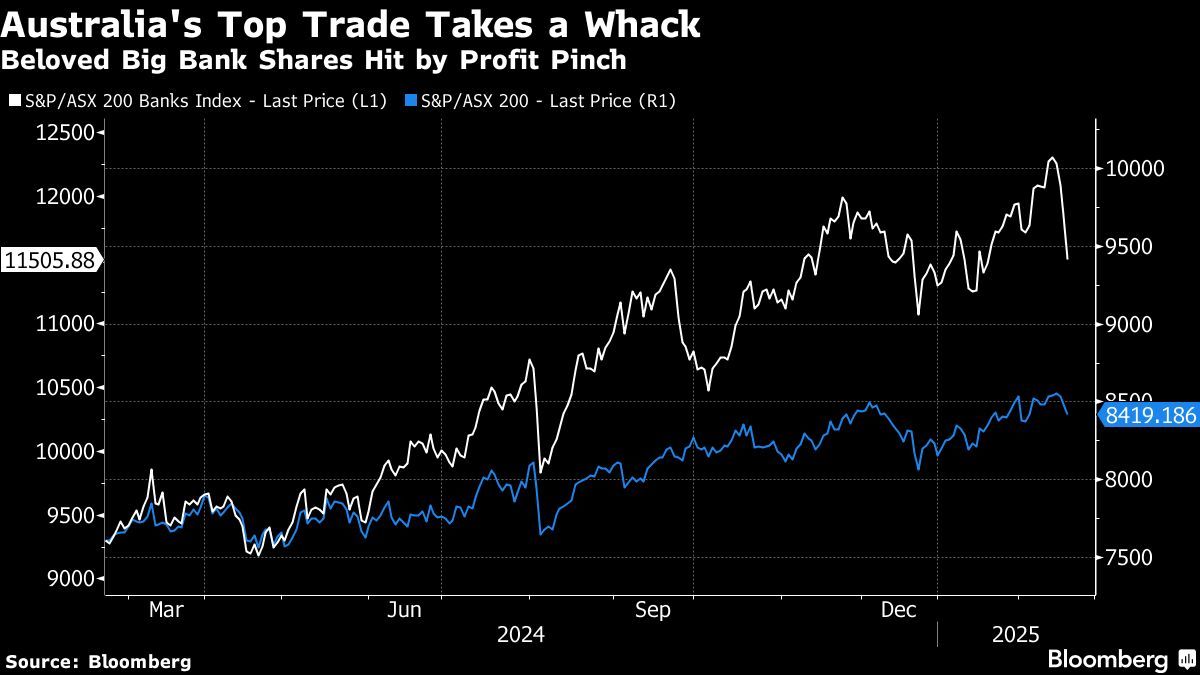
(Feb 20): A US$26 billion (RM115.22 billion) rout in Australia bank stocks this week after two of the biggest lenders reported increasing margin pressure is fuelling concern about the sector’s profitability.
National Australia Bank Ltd (NAB) has tumbled 15% since a week ago, while Westpac Banking Corp lost 9.7%. Both firms updated shareholders with quarterly revenue figures that indicated the industry’s core profit metrics were under pressure from intense competition.
Adding to the negativity was smaller lender Bendigo & Adelaide Bank Ltd, after it disclosed huge margin pressure in its business banking book. ANZ Group Holdings Ltd shares fell 3.5% on Thursday, after it reported that mortgage restructures led to a jump in impaired assets.
The tumult marks a sharp reversal in fortune for some of last year’s stock market winners. After driving gains on the S&P/ASX 200 Index in 2024, long-cited valuation concerns appear to have caught up this week.
“After an extraordinary run-up, the banks are finally starting to miss expectations, and the lofty valuations make them particularly vulnerable to any misses, however minor they are,” said Matthew Haupt, a portfolio manager at Wilson Asset Management in Sydney. “Its been an 'underweight' call for domestic managers for a long time, albeit an incorrect one, but that call looks to be working now.”
Australia’s five largest banks — Commonwealth Bank of Australia, ANZ, Macquarie Group Ltd, along with Westpac and NAB — accounted for about 70% of the total return on the S&P/ASX 200 index in the last 12 months, according to data compiled by Bloomberg.
Additional headwinds are growing. The first interest rate cut since 2020 from the Reserve Bank of Australia this week will erode profitability for a sector that’s already moved to lower home loan rates. Adding to the pressures are early signs that a long-running war for market share between the banks to win mortgage-writing business is starting to seep into commercial lending as well.
“We have been selling Commonwealth Bank, particularly in December last year, and that didn’t look too smart, but it was a small amount,” said Hugh Dive, the chief investment officer of Atlas Funds Management Pty Ltd. “A number of prominent analysts were saying sell all banks in about February or March last year, which if you’d done that, you would have probably been looking for a job in December.”
Westpac’s net interest margin — a core profit metric — fell two basis points in the first quarter in what some read as a harbinger for the whole sector given expected rate cuts.
“The modest decline reflects prudent management in the context of ongoing mortgage competition and further deposit mix shift towards lower spread savings and term deposits,” Westpac chief executive officer Anthony Miller said on Monday.
NAB’s competitive edge in commercial lending has higher margins, but has been attracting new competition from peers. As a result, business lending balances rose at a slightly slower 2%, which includes 1% growth in small-to-medium business lending, CEO Andrew Irvine told investors.
This week’s market losses in Australia appears to be an outlier. Shares of Singapore banks DBS Group Holdings Ltd and United Overseas Bank Ltd (UOB) have soared on plans by the lenders to return surplus capital to shareholders. In the US, some top banks have pledged that portions of their growing profits will be returned to shareholders after a blow-out earnings season on Wall Street.
There is still cause for cheer in Australia. The banks are holding a lot more capital and have tighter lending requirements, limiting bad loans from reaching rates many analysts have in their downside scenarios, Dive added.
“Looking at it closely, their results will probably be reasonable profit growth, probably a higher dividend, and just very low bad debts,” he said.
Uploaded by Tham Yek Lee
- Majujaya files petition to wind up Bina Puri for failure to pay RM30m awarded by court
- Jentayu signs 40-year power purchase agreement for RM2.8b 162MW Sabah hydropower project
- Pak Lah passed away in IJN this evening, says KJ
- Zarul Ahmad now says his firm received distinct advantage from Guan Eng in bid for Penang undersea tunnel project
- Malaysia’s key US leverage: Electronics, chips, rare earths, gloves and security — Kenanga
- French opposition parties raise spectre of no-confidence vote over 2026 budget
- Pak Lah passed away in IJN this evening, says KJ
- Tech stocks power Wall St higher after Trump's tariff relief for some electronics
- Pak Lah, a gracious statesman who redefined Malaysia's political narrative — Anwar
- PH-BN cooperation for Sabah polls to be finalised — Loke

